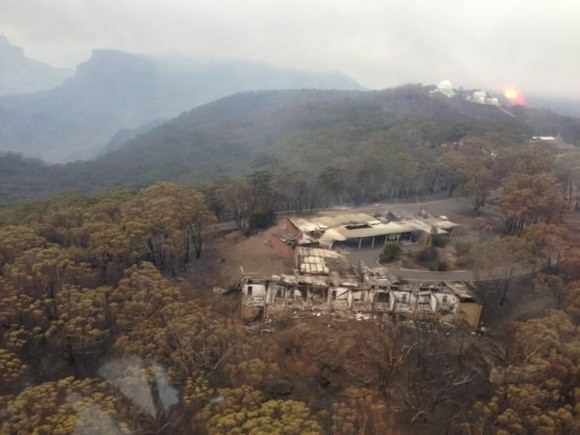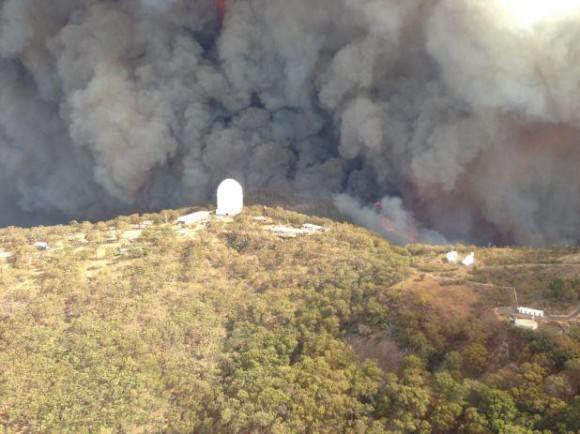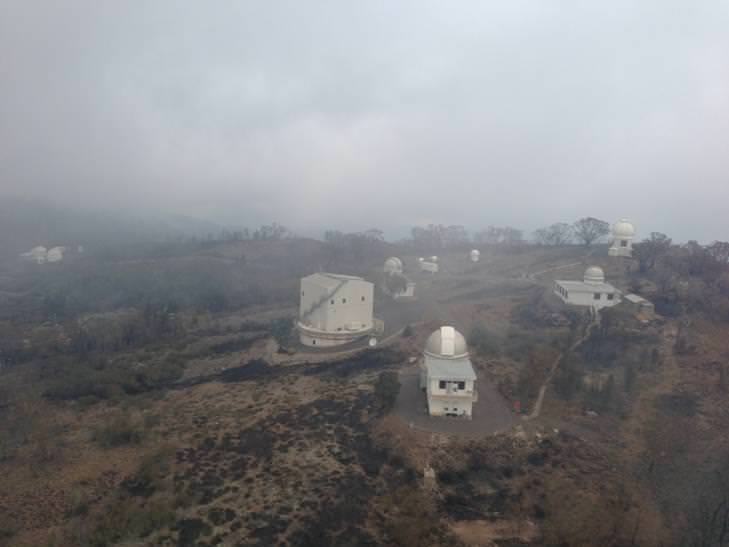The Siding Springs Observatory complex has suffered damage from wild fires burning across New South Wales, Australia. An initial assessment, according to the Australian National University, indicates that while no telescopes appear to have received major damage, five buildings have been severely affected or damaged, including the Lodge used to accommodate visiting researchers and a number of cottages and sheds. Additionally, it appears the Visitor Center has been severely damaged.
Apparently, firefighters from the New South Wales Rural Fire Service worked through the night to save the telescopes. “This is a large and dangerous bush fire,” the RFS said. Crews were battling difficult conditions, with temperatures in the area above 40 degrees Celsius (104 Fahrenheit) and hot north-westerly gusts of about 60 kilometers per hour, according to news reports.

The observatory is located in the Warrumbungle National Park to the West of Coonabarabran, about 500 kilometres (310 miles) north-west of Sydney. Siding Spring is the largest optical observatory in Australia and a major infrared observatory that is home to 10 operating telescopes run by international researchers.
Astronomer Amanda Bauer, who works for the Australian Astronomical Observatory, provided updates and images on her blog over several hours, maintaining watch on all-sky webcams that overlook the observatory complex. See her complete coverage from January 13, and an update as morning dawned on January 14 in Australia.
All observatory staff were evacuated before the fire and were safe, according to astronomer Robert McNaught, who posted an update on a comet and asteroids researchers user group site. Unfortunately, several homes in the area were destroyed.
Ten years ago this week the Mt. Stromlo Observatory in Australia was almost completely destroyed by bush fires.

Temperatures inside some of the telescopes were dangerously high, according to remote readings, and some damage may have occurred to the delicate instruments. Until the staff can return to the complex and check on the telescopes, the extent of the damage won’t be known.
“I fear a lot of damage has been done though, even if not the wholesale destruction we faced in 2003 at MSO,” said astronomer Brian Schmidt, who heads the SkyMapper telescope at the site, via Twitter. “Tomorrow will tell, and then will come the long, slow process of recovery.”
Additional sources: Australian National University, 9 News.


A shame, but It’s a lot easier to re-build a telescope observatory than it is to re-build peoples homes and lifestyles. Good luck to the firefighters, most of whom are volunteers.
Of course when a home is burned there are personal items lost that are irreplaceable. But a big telescope, mount, and associated goodies are worth much more financially than a house.
We lost over 200 people in one day 4 years ago in fires around Melbourne, so I’m sure everyone up there is happy just to have not lost any lives. I’ve driven through that national park many times, it’s thick bush up there, I’m sure there were some pretty hairy moments. The NSW RFS has had a crazy past week, and it’s not cooling down anytime soon with Thursday and Friday looking to be scorchers across the country.
I would imagine now, that any new telescope designs will not include vegetation by having a few layers of trap rock (maintained frequently for driving and parking service) as means to drive vehicles around or to the site and be protected for at least a mile in radius where no flammable brush could thrive. This being done, it would keep the fire and heat away from the buildings and greatly lesson or minimize any damage the buildings.
Did the heat affect the lenses?
Very glad that no lives were lost and that the telescopes were preserved; however I am delighted to hear that the visitors centre will need to be rebuilt. It was a dreadful old building with displays dating back to the 80’s and possibly earlier.